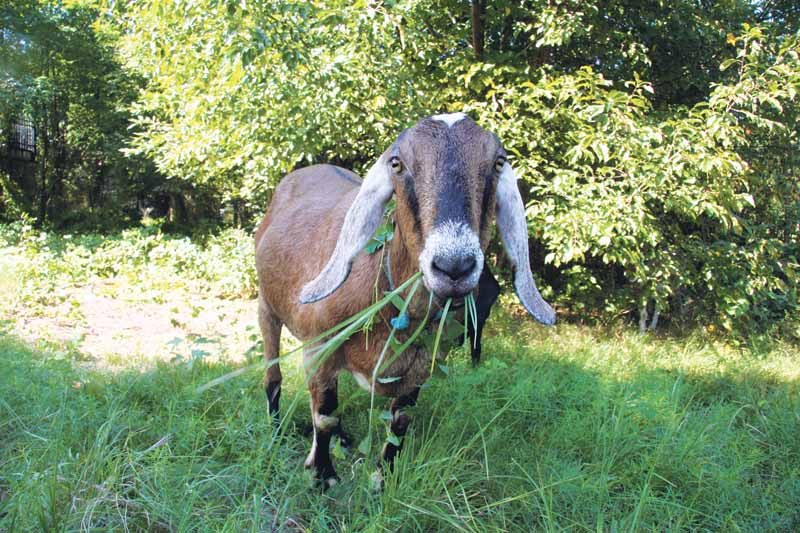
Herd fights invasive species at Underhill Preserve
A herd of goats is mowing its way through invasive plant species in Jericho’s Underhill Preserve through the efforts of the state Department of Environmental Conservation (DEC).
The picturesque, but inaccessible swath of land near Jericho Turnpike and Route 106 has become inundated with such problematic plants as autumn olive, mugwort, multiflora rose, Japanese honeysuckle, mile-a-minute, porcelain berry, garlic mustard and other species that have crept into the fields, woods and trails that make up the property, reducing habitat for birds, butterflies and other wildlife.
The munching mammals were deployed as part of a green effort on behalf of the state to increase public access of outdoor recreational opportunities for all residents. Planning for public access is currently underway and will begin in the coming years.
“In the past we have seen that goats can be a very effective tool in controlling the spread of invasive species,” said Carrie Meek Gallagher, DEC regional director. “With their voracious appetites, they can chew and mow their way through thickets of invasive species far better than mechanized equipment which allows native plants the opportunity to re-vegetate their former areas.”
In 2014, the DEC brought in 10 goats to its 812-acre Edgewood Oak Brush Plains State Preserve near the shared borders of Babylon, Islip and Huntington where they are credited with devouring nearly six acres of invasive species. Officials are hoping for similar results at Underhill Preserve, which was acquired by the state, Nassau County and the Town of Oyster Bay in October 2002. The 75-acre total preserve of undeveloped land is located at the northwest corner of routes 106/107 and Jericho Turnpike.

According to the DEC, the seven goats that have been brought to the preserve and are a mixture of Nubian and domestic stock. Additional goats will be added to the herd for a total of 10 that will remain at the preserve from August until mid-October. The goats will be housed within a six-acre solar powered electric fence to prevent their escape and to protect the goats from potential predators. Officials stress that the current in the fence will act as a deterrent, but will not harm animals that come in contact with it.
A shelter will also be constructed for them at the preserve and DEC forest rangers and natural resources staff, along with volunteer groups and the owner of the goats will care for the animals during their two-month stay at the preserve. Autumn olive and mugwort are the invasive species that will most likely be targeted by the goat herd.
Funding for this project came from a close-to $40,000 grant from the United States Fish and Wildlife Service, which was lobbied for and awarded to the Huntington-Oyster Bay Audubon Society (HOBAS), which transferred the funds to the DEC for the restoration project.
Prior to developing the plan to deploy goats to the Underhill Preserve, HOBAS worked with the DEC to identify important animal and plant species within the preserve.
 “We look forward to working with the DEC and the surrounding community in the upcoming years as we work to restore and maintain habitat for the protection of wildlife and the enjoyment of the public,” Huntington-Oyster Bay Audubon Society president Stella Miller said. “With invasive plant species threatening so many of our preserves, it is vital that these preserves be managed in a way that will maintain ecological diversity and health. We are pleased to receive funding that will help facilitate efforts to restore, create and protect critical bird and butterfly habitat. In the past five years alone, we have observed a steep decline in the birds and butterflies using the preserve.”
“We look forward to working with the DEC and the surrounding community in the upcoming years as we work to restore and maintain habitat for the protection of wildlife and the enjoyment of the public,” Huntington-Oyster Bay Audubon Society president Stella Miller said. “With invasive plant species threatening so many of our preserves, it is vital that these preserves be managed in a way that will maintain ecological diversity and health. We are pleased to receive funding that will help facilitate efforts to restore, create and protect critical bird and butterfly habitat. In the past five years alone, we have observed a steep decline in the birds and butterflies using the preserve.”
In addition to deploying goats to combat invasive species growth, the DEC is using grant money to develop and implement plans for additional grassland, meadow and shrub land preservation efforts on the Underhill property. These efforts are aimed at restoring and creating wildlife habitat. Ten species of state threatened and endangered plants have been documented in Underhill by a survey funded by HOBAS in 2013, with a total of approximately 350 plant species confirmed.
More than 100 species of birds have been documented as well as the Eastern box turtle, a state-listed species. The chapter is currently conducting breeding bird surveys in the preserve to add to the general avian data. Also found on the preserve are monarch butterflies known for their yearly thousand-mile plus migration to their winter home in Mexico.































